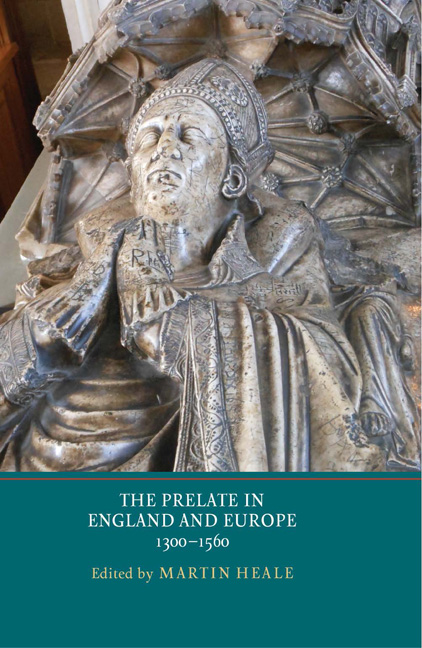Book contents
- Frontmatter
- CONTENTS
- List of Illustrations
- List of Contributors
- Preface and Acknowledgements
- List of Abbreviations
- Introduction
- Part I Prelates and Power
- Part II Patronage and Learning
- Part III Identity and Display
- Treasure, Material Possessions and the Bishops of Late Medieval England
- Episcopal Embodiment: the Tombs and Seals of Bishops in Medieval England and Wales
- Cistercian Abbots as Patrons of Art and Architecture: Northern England in the Late Middle Ages
- Cistercian Abbots in Late Medieval Central Europe: Between the Cloister and the World
- Part IV Attitudes towards Prelacy
- Index of People and Places
- Index of Subjects
- YORK MEDIEVAL PRESS: PUBLICATIONS
Cistercian Abbots in Late Medieval Central Europe: Between the Cloister and the World
from Part III - Identity and Display
Published online by Cambridge University Press: 05 November 2014
- Frontmatter
- CONTENTS
- List of Illustrations
- List of Contributors
- Preface and Acknowledgements
- List of Abbreviations
- Introduction
- Part I Prelates and Power
- Part II Patronage and Learning
- Part III Identity and Display
- Treasure, Material Possessions and the Bishops of Late Medieval England
- Episcopal Embodiment: the Tombs and Seals of Bishops in Medieval England and Wales
- Cistercian Abbots as Patrons of Art and Architecture: Northern England in the Late Middle Ages
- Cistercian Abbots in Late Medieval Central Europe: Between the Cloister and the World
- Part IV Attitudes towards Prelacy
- Index of People and Places
- Index of Subjects
- YORK MEDIEVAL PRESS: PUBLICATIONS
Summary
From the very beginning of monasticism, the role of the abbot was central to the way in which communities of monks functioned on a practical and spiritual level. The abbot was the father and spiritual leader of the community, responsible for guiding the monks towards salvation by preaching, taking confessions, and officiating in the liturgy, while, at the same time, he was head of the monastic community in all its temporal functions. In the twelfth century, the abbot was often the only ordained priest in many Cistercian communities. The Benedictine tradition emphasized hierarchical dependence and total obedience to the abbot: ‘the Abbot represented Christ, and his monks obeyed his command as if they were wishes from God’. Although Cistercian observance was based on the Rule of St Benedict, the white monks curbed the autocratic power of their abbots by the structure of the Chapter General, the filiation system and visitations. This uniformity of practice was also intended to prevent arbitrary decisions of abbots in the very important matter of the liturgy – the leaders of individual communities were not supposed to introduce any changes to the order-wide form of liturgy. Unlike Benedictine abbots who held their position for life, it was not unusual for Cistercian abbots to resign and occasionally even to be deposed if they were seen, by the abbot of the mother house or other delegate of the General Chapter, to fail seriously in their duties.
- Type
- Chapter
- Information
- The Prelate in England and Europe, 1300–1560 , pp. 240 - 258Publisher: Boydell & BrewerPrint publication year: 2014

